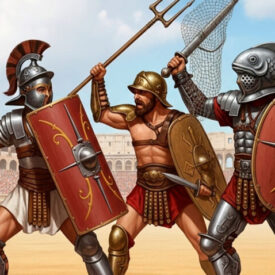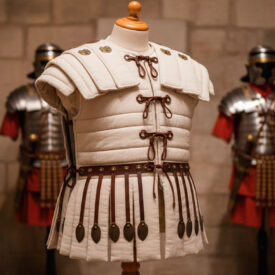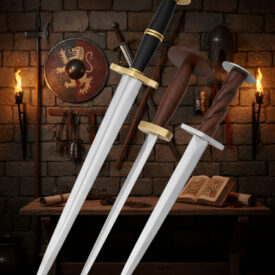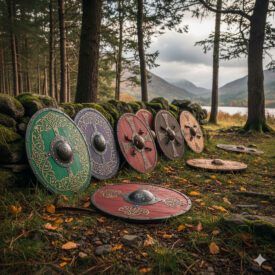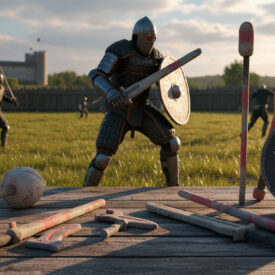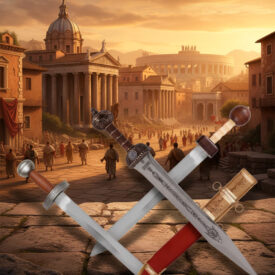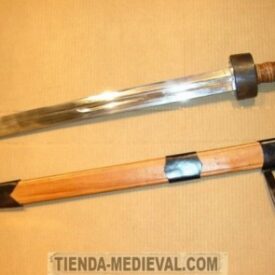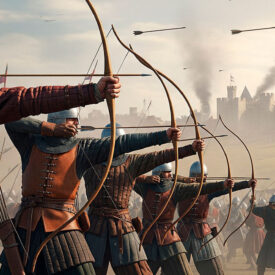A Rain of Iron: How the Pilum Changed the Way of Fighting
Imagine the tense silence of a battlefield where thousands of men await the clash. Suddenly, a coordinated volley cuts through the air: dozens of javelins pierce shields, wood, flesh. The pilum was not just a weapon: it was a psychological and technical tool that disorganized ranks and dictated how the Roman legion entered combat.
This article guides you through the origin, usage technique, variants, and evolution of the Roman pilum. You will learn why its design was so effective, how it integrated into legionary tactics, and why, despite its success, it was eventually replaced by new weapons. If you are interested in historical reenactment, replicas, and the science behind the projectile, here you will find a rigorous and evocative analysis.
Chronology and Evolution: The Pilum’s Journey Through the Centuries
Before describing its tactical use and construction, it is essential to look at the historical trajectory of the pilum. This chronology shows how a technological idea was transformed into a military standard and how, centuries later, it was replaced by responses to new challenges on the battlefield.
| Era | Event |
|---|---|
| Early Origins (8th – 5th Centuries BC) | |
| 8th Century BC | First attributed examples in the Samnium region. |
| 5th Century BC | Pilum recorded in Lucania and Etruria; possible Etruscan invention. |
| 6th–5th Centuries BC | Oldest remains of pila with cubic sockets in the center of the peninsula (Latium, Umbria, and Etruria). |
| 5th–4th Centuries BC | Clusters of findings in northern Italy (Cisalpine Gaul), indicating early spread and use. |
| Adoption and Republican Era (4th – 1st Centuries BC) | |
| 4th Century BC | Romans begin using and perfecting a type of pilum, adopted from the Etruscans; from then on, legionary infantry (except the triarii) is equipped with the weapon. |
| Mid-4th Century BC | Proposal for adoption by the Romans around this period (according to Jeremy Armstrong). |
| 225 BC (3rd Century BC) | Talamonaccio examples linked to the Battle of Telamon; first clear documentations in Roman hands. |
| Second Punic War (late 3rd Century BC) | Widespread introduction of the pilum as new equipment; coexistence of heavy and light pilum. |
| Around 200 BC | Hastati and principes replace the hasta with a pair of pila; Polybius describes its use in 216 BC. |
| 104 BC | Gaius Marius’s reform, contributing to the generalization of the pilum in the legion; the wooden rivet is introduced (occasionally) for the shaft to bend on impact. |
| Before late 1st Century BC | The triarii also adopt pila. |
| 1st Century BC | Caesar and Plutarch mention the replacement of the iron pin with a wooden one to render the pilum useless on impact; use of the pilum in hand-to-hand combat (Pharsalus) and in campaigns like Mark Antony’s against the Parthians. |
| Republican Era (archaeology) | Important findings in Hispania: Osuna, Numancia, Cáceres el Viejo, La Almoina de Valencia, Castellruf, among others. |
| Imperial Era and Transition (1st – 4th Centuries AD) | |
| 1st Century AD | Flat-tongued pila are very common; heavy and light pilum tend to be identical. The lancea gains prominence, first among cavalry and then in auxiliary infantry. |
| c. 100 AD | A metal ball weight is added to increase penetration and help bend the shaft after impact. |
| Early 3rd Century AD | The pilum is simplified and its importance begins to decline; gradual replacement by other weapons, especially the lancea. |
| Late 3rd Century AD | The pilum is replaced by more suitable spears against cavalry; the lancea grows in size and ceases to be primarily for throwing. |
| Late 3rd Century AD | Appearance of the plumbata (martiobarbulus): heavy dart with a range of up to 60 meters (approx. double that of pilum or lancea), a great innovation in projectiles of the era. |
| 3rd–4th Centuries AD (Late Empire) | The pilum is still used, but its presence diminishes. Vegetius (4th–5th Centuries AD) indicates that from the 4th Century AD it is called spiculum and laments the almost complete disappearance of the pilum, also describing the plumbatae. |
| Summary | |
| Legacy | The pilum was essential in Roman tactics during the Republic and the High Empire, undergoing technical modifications (wooden rivets, weights, profile variations) until it was displaced by more effective weapons against cavalry and in the new tactical context of the 3rd–4th Centuries AD. |
What exactly was a pilum and how was it constructed?
From a technical perspective, the pilum is a combination of materials and geometry designed for a clear purpose: to penetrate defenses and become useless to the enemy. Its strength lay not in its exoticism, but in the intelligent simplicity of its design.
Essential Components
- Wooden shaft: generally made of ash or walnut, strong and somewhat flexible to absorb impact.
- Iron head or shaft: a long, thin rod, often with a prismatic or cylindrical cross-section, ending in a sharp pyramidal point.
- Rivets/pins: fastened the head to the shaft; in some models, one of them was intentionally made of wood to promote breakage on impact.
- Weight (in imperial versions): a metal ball placed at the junction or on the body to increase inertia and penetration.
The total length was around 2 meters in classic examples, although there were regional and temporal variations. The iron head could measure between 40 and 70 cm, which concentrated the weight towards the tip and multiplied the impact energy.
| Type | Total Length (approx.) | Shaft Length | Estimated Weight | Specialty |
|---|---|---|---|---|
| Republican Pilum (standard) | ~2.0 m | 40–60 cm | 1.5–2.5 kg | Balance between penetration and manageability. |
| Heavy Pilum | ~2.0–2.2 m | 50–70 cm | 2–3 kg | Greater piercing power; used in front lines of attack. |
| Light Pilum | ~1.7–2.0 m | 35–45 cm | 1–1.8 kg | Easier to throw in long volleys; higher firing speed. |
- Republican Pilum (standard)
-
- Blade Length: 40–60 cm (approx.)
- Weight: 1.5–2.5 kg
- Use: Coordinated volleys to break shields.
- Heavy Pilum
-
- Blade Length: 50–70 cm
- Weight: 2–3 kg
- Use: Maximum penetration against robust defenses.
- Light Pilum
-
- Blade Length: 35–45 cm
- Weight: 1–1.8 kg
- Use: Maintain rhythm and cadence in volleys.
Legionary Tactics: How and Why the Pilum Was Thrown
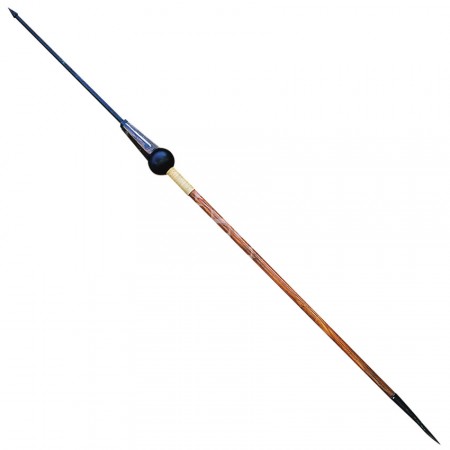
The simple appearance of the pilum conceals a military synchronicity learned through discipline. It was not about throwing darts randomly, but about executing a maneuver designed to maximize chaos in the enemy formation.
Phases of Use
- Coordinated approach: the legionaries advanced in dense formation, at a controlled distance from the enemy.
- Volley discharge: at about 15–30 meters, soldiers threw their pila in groups, seeking to pierce shields and sow confusion.
- Transition to hand-to-hand combat: after the rain of pila, units broke the enemy formation and attacked with the gladius and pugio.
The sought-after effect was manifold: to pierce or snag enemy shields, forcing adversaries to discard their protection, and to cause casualties or injuries that would break the cohesion of the line. The psychological force of a “rain” of projectiles should not be underestimated: many battles were decided by demoralization and loss of order.
Did the pilum really bend on impact?
There is a popular idea that states the pilum was designed to bend easily and thus become useless. The reality is more nuanced. Some variants incorporated a wooden pin or a joint design that facilitated shaft breakage or deformation after impact. Others rely only on the thinness of the iron to bend. In all cases, the intention was clear: to prevent the enemy from reusing the weapon and, incidentally, for the pilum to remain stuck in the rival shield.
Replicas, Use in Reenactment, and Where to Find Models
For those who reenact battles or collect replicas, understanding the historical variations of the pilum is key to choosing a faithful model. Some modern reproductions add a metal weight or use contemporary rivets, striking a balance between authenticity and functionality.
Below are representative images to help you visualize the typical shapes and proportions of the pilum, distributed throughout the text to maintain narrative flow and facilitate visual comparison.
The previous photograph helps to appreciate the total length and the relationship between shaft and head. Observe how the metal rod extends several decimeters, concentrating mass and penetration capability.
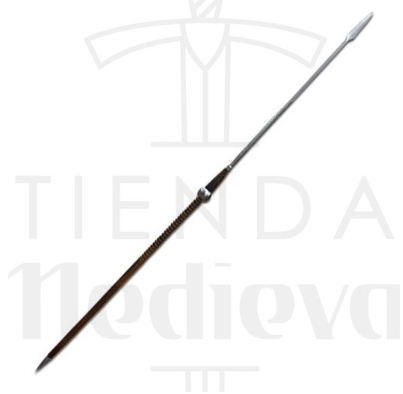
The image shows the pyramidal tip and the section of the shaft; decisive elements for penetrating fiber and wood. Functional replicas aim to reproduce that profile and the necessary rigidity for an effective throw.
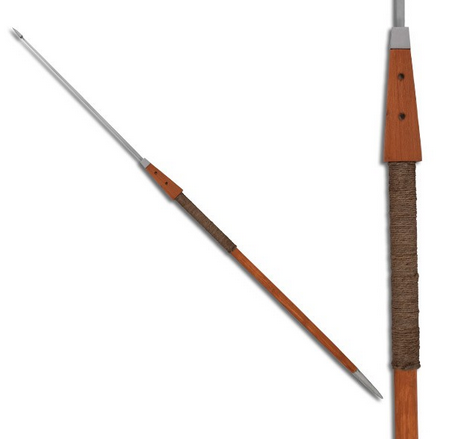
Modern functional versions often balance authenticity and safety. For reenactments, steels and treatments are used to prevent dangerous fractures and allow for controlled throws to be practiced.
The photographs show useful details: the joint of the shaft with the haft, possible rivets, and the ball-shaped weight incorporated in some imperial variants. When choosing a replica, consider the purpose: display, reenactment, or functional use in controlled practices.
Comparison: Pilum vs. Other Roman Javelins and Projectiles
In the Roman arsenal, there were several throwing weapons. Understanding their differences helps to see why the pilum held its central place and why it was displaced over time.
| Weapon | Effective Range | Main Function | Advantage | Limitation |
|---|---|---|---|---|
| Pilum | 15–30 m | Disorganize and pierce shields | High penetration and demoralizing effect | Short range compared to darts and light javelins |
| Plumbata | 40–60 m | Range and penetration at greater distance | Greater range and distant accuracy | Less mass for direct impact |
| Lancea | variable | Versatile: throwing and hand-to-hand | Adaptable to multiple roles | Less specialization in massive shield penetration |
Practical Use in Reenactment
If you participate in reenactments, keep safety regulations in mind. Many groups allow harmless replicas to simulate aesthetics, and functional replicas only in safe areas and under supervision. In any case, understanding the weight, center of gravity, and flight behavior is essential to avoid accidents.
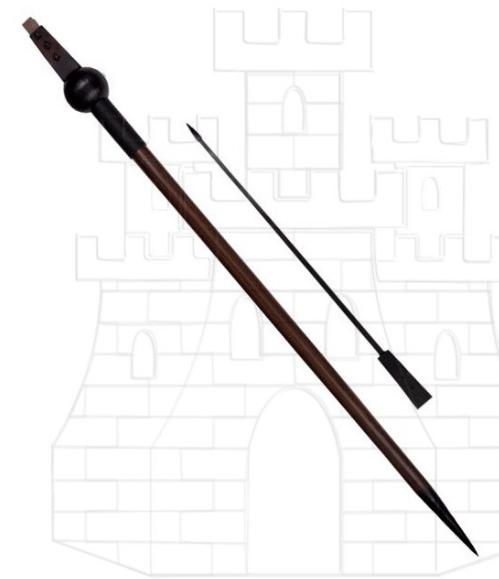
Experimental Archaeology: What Modern Tests Teach Us
Modern experiments with replicas have confirmed several expected results. A pilum thrown at close range can penetrate 3 cm thick pine boards and protrude tens of centimeters on the other side. It has also been observed that, depending on the joint design, the iron shaft tends to deform or get stuck, achieving the objective of rendering the enemy’s defense useless.
These tests not only justify ancient written sources but also help modern craftsmen produce replicas with consistent behavior. For collectors, it is a reminder: historical fidelity comes down to physics, not just aesthetics.
How to Choose a Pilum Replica: Practical Criteria
If your interest is to have a replica for display or reenactment, evaluate these factors:
- Materials: ash or walnut wood for the shaft, steel or iron for the head.
- Length and weight: that they match the historical period you seek to reproduce.
- Joining method: metal rivets for display; a wooden pin better recreates historical functionality.
- Safety certification: in case you want to use it in controlled throws.
Deciding between authenticity and safety is common: a 100% functional replica is spectacular but requires safety protocols and responsibility.
The Tactical Legacy of the Pilum: Lessons for Strategists and Enthusiasts
The pilum demonstrates a universal lesson about military technology: effectiveness depends as much on form as on use. It is not enough to have a powerful weapon; it must be integrated into doctrines and training. The Roman legion did not win only because of its weapons, but because of its discipline in employing them at the precise moment.
Today, for enthusiasts, the pilum is also a symbol: the idea that practical innovation, applied with discipline, can change the course of history. That lesson remains alive in historical reenactment and in the manufacture of replicas that seek to honor form and function.
VIEW MORE ROMAN PILUM | VIEW MORE SPEARS | VIEW MORE POLEARMS

